- jwebb's home page
- Posts
- 2019
- 2018
- 2017
- 2016
- 2015
- 2014
- 2013
- November (1)
- October (1)
- September (1)
- July (1)
- June (1)
- April (1)
- March (3)
- February (1)
- January (1)
- 2012
- 2011
- December (2)
- September (3)
- August (5)
- July (6)
- June (6)
- May (1)
- April (5)
- March (5)
- February (2)
- January (2)
- 2010
- December (3)
- October (3)
- September (2)
- August (2)
- June (2)
- May (4)
- April (4)
- March (2)
- February (4)
- January (10)
- 2009
- 2008
- 2007
- 2006
- July (1)
- My blog
- Post new blog entry
- All blogs
Comparison of muon energy deposit in 1st layers of EEMC and BEMC in gstar
Abstract: Muons are thrown with energy of 100 GeV at eta = 0.025 and eta = 1.85. Energy-loss distributions in the first layer of plastic and the first layer of lead are compared between the BEMC and EEMC, and compared with expectations of mean energy loss based on the particle data book. The mean energy deposit in the BEMC appears to be modeled correctly, within a few %, compared with the values tabulated in the particle data book. The EEMC is not well modeled. Energy deposit is 20% too low for both the lead radiators and plastic scintillators.
07/25/2009 -- NOTE: What follows is flawed. The tail of the muon dE/dx distribution is significant, and one must thrpw sufficient events to see events with ~5% energy lost to accurately determine the means.
There is a long-standing issue with the EEMC Monte Carlo, specifically that the reconstructed pT of photons and electrons do not match the generated values by ~30%. To investigate the origin of this, we perform some simple QA checks on the EEMC and BEMC.
- muons thrown with p=100 GeV/c
- default EEMC and BEMC geometry(*)
- 50k muons thrown at EEMC, eta = 1.85
- 50k muons thrown at BEMC, eta = 0.025
Access energy loss directly from the geant common blocks at the end of each tracking step, and save to a histogram. (In subroutine AGUSTEP).
Figure 1 -- Energy loss distribution for 100 GeV muon penetrating the first lead absorber in the EEMC (left) and the BEMC (right). Very-low energy secondary tracks have been discarded below 5 MeV deposited. Expect an average of 10 MeV in the EEMC and 10.2 MeV in the barrel, based on thickness of lead and incident angles. BEMC is a few % too low, perhaps due to a few events being cut off in the tail of the distribution. EEMC is ~20% too low.
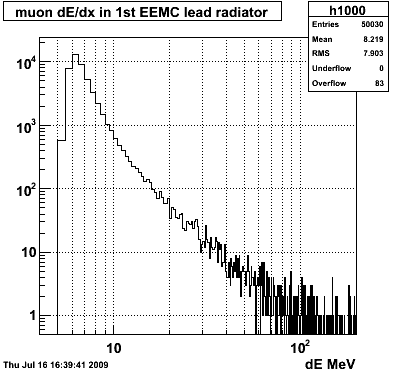
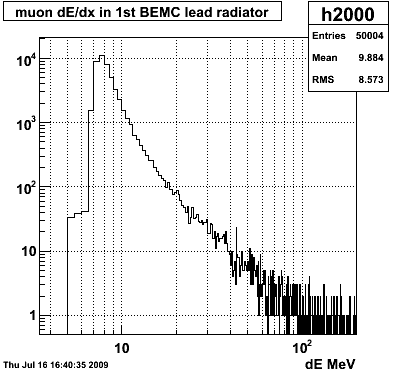
Figure 2 -- Energy loss distribution for 100 GeV muon penetrating the first plastic scintillator in the EEMC (left) and the BEMC (right). Very-low energy secondary tracks have been discarded below 0.5 MeV deposited. Expect an average of 1.34 MeV in the EEMC and 1.49 MeV in the barrel, based on thickness of plastic and incident angles. BEMC falls short on this. EEMC also falls short.
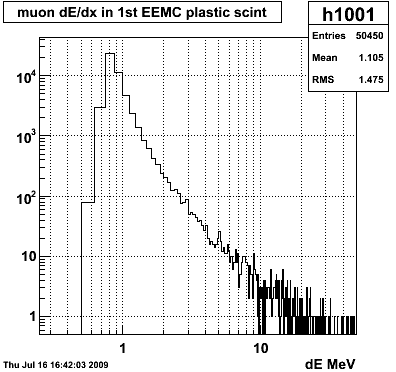
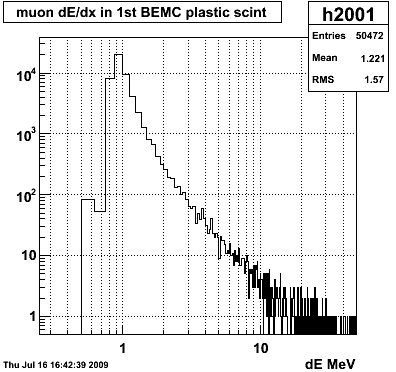
Figure 3 -- dE/dx for ionizing radiation as a function of momentum. Blue line at muon momentum. (Figure taken from pdb).
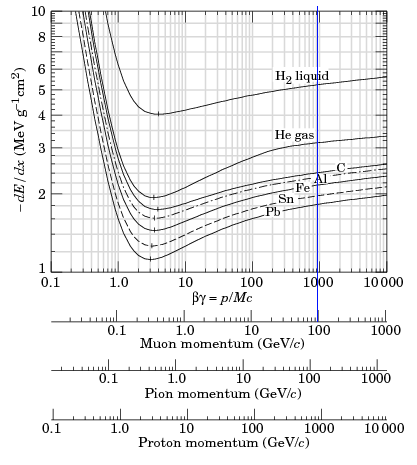
Table 1 -- Expectations based on material in geometry and published <dE/dx> vs momentum.
|
|
cos(theta_inc)
|
dE/dx|min
[MeV g-1 cm2]
|
density (geant)
[g/cm3]
|
x
[cm]
|
x / cos(t)
[g/cm2]
|
<dE>|expected
[MeV]
|
<dE>|seen
[MeV]
|
| EEMC Pb | 0.95 | 1.8 | 11.35 | 0.457 | 5.45 | 9.83 | 8.2 |
| EEMC Plastic | 0.95 | 2.4 | 1.06 (*) | 0.50 | 0.558 | 1.34 | 1.1 |
| BEMC Pb | 1.0 | 1.8 | 11.35 | 0.50 | 5.68 | 10.2 | 9.9 |
| BEMC Plastic | 1.0 | 2.4 | 1.032 | 0.60 | 0.619 | 1.49 | 1.2 |
(*) default GSTAR is 1.032. I've recompiled geometry w/ PDB value here.
Other tests:
1. Similar results found w/ default geometries.
1. Similar results found w/ default geometries.
2. Similar results w/ restricted dE/dx using LOSS 1
3. Changed EEMC geometry so that consistent cuts are set between BEMC and EEMC (used call to CALBPAR to set EEMC tracking cuts), saw same result.
4. Compute dE = sqrt(px^2 + py^2 + pz^2 + m^2)_in - sqrt(px^2 + py^2 + pz^2 + m^2)_out. No change.
Conclusions:
We have performed a basic check on the MC simulations -- does a muon traversing a given thickness of material deposit the energy expected based on known physical processses. We find that the energy deposited in the BEMC lead is close (discrepancy with expectation likely due to losing extreme energy loss events in the tail of the distribution). The energy deposited in the BEMC plastic appears to small. The energy deposited in the EEMC plastic AND LEAD is too small by 20%.
Miscellaneous:
A printout of one event, where everything except continuous energy loss for muons was disabled, and energy loss was not allowed to fluctuate.
Update:
The wrong layers were selected for the BEMC in the above study. When I select the correct layers, the BEMC lead is more consistent with the EEMC lead. But the BEMC and EEMC plastic layers are not consistent. See this link for details.
Groups:
- jwebb's blog
- Login or register to post comments
